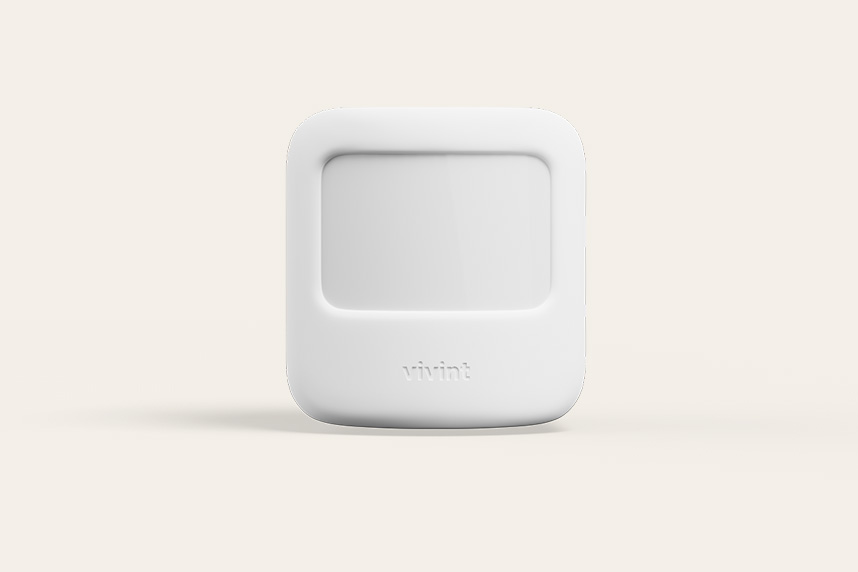Infrared tech
The Vivint Motion Sensor uses passive infrared (PIR) technology to detect heat signatures and movement within a 30’ x 50’ range—even at night. You’ll get a smartphone alert any time the alarm triggers.


The backbone of a security system, a home motion sensor alerts you to the presence of an intruder without alerting them. Instead, you’ll get an instant smartphone alert and a call from a Vivint professional, so you can take action.
The Vivint Motion Sensor forms an active “grid” of 30’ x 50’ and uses passive infrared (PIR) technology to detect heat signatures and movement within that range. Pair that with its impressive 110-degree wide-angle viewing radius and 90-degree lookdown, and you’ll find this wireless motion detector can detect almost anything that crosses its path.
Plus, its slim and sleek design means you can discreetly place it anywhere—from your front porch to your backyard patio.
The Vivint Motion Sensor comes packed with perks as the foundation of your home security system.
The Vivint Motion Sensor uses passive infrared (PIR) technology to detect heat signatures and movement within a 30’ x 50’ range—even at night. You’ll get a smartphone alert any time the alarm triggers.
Have a fur baby at home? No worries. Vivint’s motion alarm can ignore pets under 35 or 55 lb. That means you can adjust the sensitivity settings as needed to match almost any fluffy companion.
The Vivint Motion Sensor seamlessly syncs with your Vivint Smart Hub™, so the moment it detects activity, you’ll be notified. And with two-way talk, you can chat with a Vivint agent in seconds.
If your security alarm ever goes off, you may start to panic—but within just 8 seconds on average, a Vivint security agent will call to verify the alarm, contact emergency services, and help you decide what to do next. Here are a few more reasons you can trust Vivint monitoring to show up for you when it matters most:
*The Monitoring Association named Vivint Smart Home the Monitoring Center of the Year in 2017.
Vivint is committed to giving you quality service at every step, including installation. That’s why Vivint carefully vets and trains every installation tech it hires, and never outsources the job to third-party dealers. Feel more comfortable and confident on installation day knowing that your Vivint Smart Home Pro™ will get the job done right.
Color | bg-white |
Size | 3.2" H x 2.8" W x 2.0" D |
Frequency | 345 MHz |
Battery | 2 CR123A lithium batteries |
Battery life | 3–5 years |
Mounting | Screws and bracket |
Product plan protection | 1 year or the length of your Vivint Service Agreement, whichever is longer. |
Other | 40’ d x 50’ w max protection
75° field of view coverage
2 pet immunity settings
Battery life depends on traffic in the home |
How do I change the battery in my Vivint motion detector?
It’s simple! First, disarm your system, unscrew your motion detector, and dismount it. From there, you can pop out your used CR123A batteries and place in new ones. Since these lithium batteries are a similar cylindrical shape to an average household battery, there aren’t any special techniques needed. Plus, they last for 3–5 years, so you won’t need to do this often.
Can a motion sensor be triggered by light?
Since the Vivint Motion Sensor detects heat, light can trigger the motion detector alarm if that light is hot enough.
What do motion detectors do?
Vivint motion detectors use passive infrared (PIR) technology to detect heat and movement within a 30’ x 50’ range. These wireless motion sensor alarms then alert you via the Vivint Smart Home® App, where you can connect to a Vivint monitoring agent 24/7.
How do motion sensors work in the dark?
Motion detectors work in the dark by sensing heat and movement, so your Vivint Motion Sensor alarm works just as effectively day or night.
How far can a motion sensor detect?
The Vivint motion detector sensor can detect heat and movement within a 110-degree angle and a range of 30’ x 50’.






